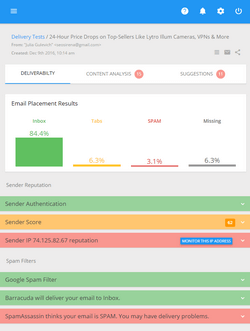Why Email Ends Up in the Yahoo Spam Folder
During the last month we received a number of emails from our customers who complained of having troubles with delivering their messages to Yahoo email addresses. Despite correctly setup sender authentication records (SPR, Reverse DNS, DomainKeys) emails were moved to the spam folder on Yahoo.
When researching the problem I found the answer on deliverability.com. According to them Yahoo has recently changed their requirements for sender reputation which determined the message placement. This change affects mostly the senders who use many “From” email addresses from the same domain and IP. Even whitelisted email senders faced this issue.
Now Yahoo determines the reputation for the message placement based on the aggregate of these elements: “From” email address, Domain name and IP address. In the past, only the domain and IP were taken into account. If they passed the tests, the message was delivered to the Inbox.
Now they rely on an individual reputation of each “From” email address when the sending domain and IP address are the same. With that said, if the reputation of a “From” email address is not acceptable, your messages won’t be delivered to the Inbox anymore.
Here is an example:
Let’s imagine we use these “From” email addresses to send the messages to our Yahoo subscribers [domain name and IP are the same]:
1. info@test.com
2. orders@test.com
3. newsletter@test.com
Let’s suppose that the 1st and 2nd email addresses have good reputations with Yahoo and the 3rd email has an unacceptable reputation because we use it to send regular newsletters to our subscribers and some of them report our emails as spam from time to time.
According to new requirements the message from the first two emails will be delivered to the Inbox and the message from the 3rd email address will end up in the Yahoo’s Spam folder.
So, if you send messages from multiple email addresses and the reputation of any of them does not meet Yahoo’s requirements, you are likely to face problems with delivering messages to your Yahoo subscribers.
In this situation obtaining a new “From” email address with a neutral reputation can be a solution with reserve that it will be gaining a positive reputation and that your existing domain and IP address have also good reputations.
Yahoo won’t ignore the available information about the sender if he uses a new “From” email address. They just added a new filtering procedure, others remain in place.
Each element in the chain “From” email address – Domain name – IP address” has its own kit of tests your message passes through.
Domain name is checked for return path, DomainKeys, SPF and reputation. IP is checked for authentication, reputation and security. “From” email address seems to have only reputation at this time. Then the message passes through the subject and content filters.
So, it seems Yahoo has just added a new element — “From” email address — to its filtering process while other elements are in place.
In order your new “From” email address gains a good reputation, make sure that you:
– use an opt-in or double opt-in process
– send relevant messages
– follow email frequency you promised
– remove bounce and unsubscribe emails
– process your spam complaints
– monitor your sender reputation at reputationauthority.org, senderbase.org, senderscore.org
If you improve your email marketing practices, you will be able to build a positive reputation for your new “From” address with Yahoo and improve the deliverability for your Yahoo subscribers.
